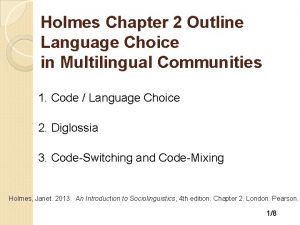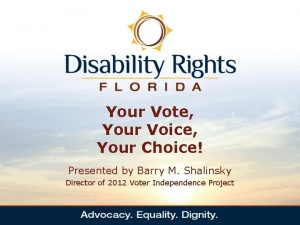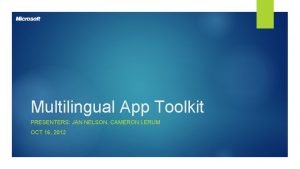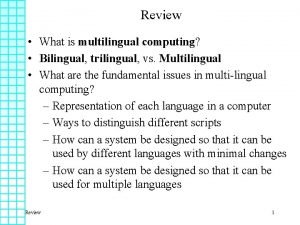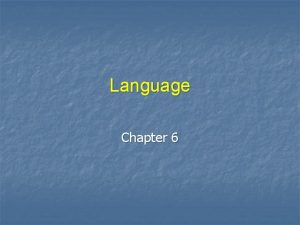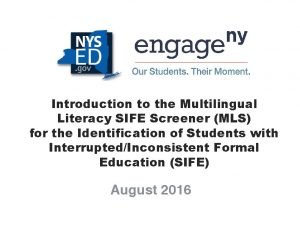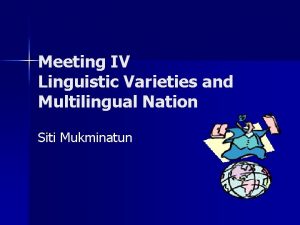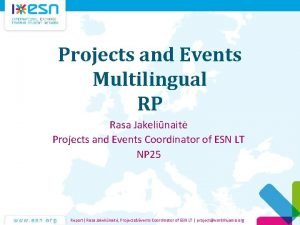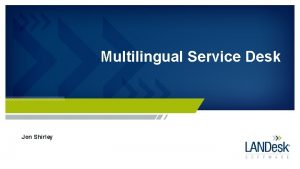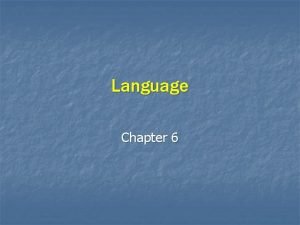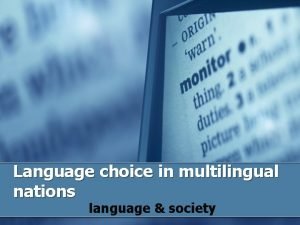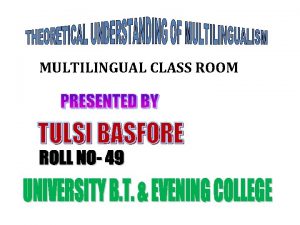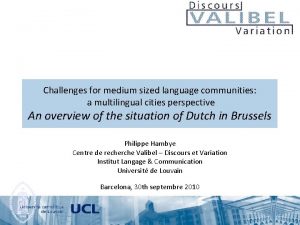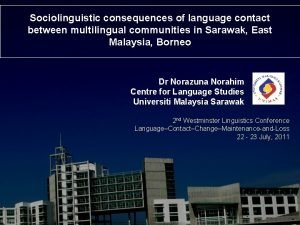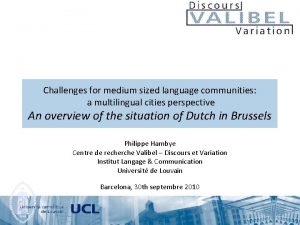Language choice in multilingual communities Q Discuss your




















- Slides: 20

Language choice in multilingual communities

Q: Discuss your own language use (p. 22)

Q: Discuss limitations of a domain-based approach to language choice

Q: Discuss factors that may account for the code choices in example 5 (p. 25)

Q: Discuss all the possible social factors affecting code choice (p. 25 -26)

Q: Discuss 3 features of diglossia (p. 27)

Q: Discuss your own use of H and L variety in diglossia situations (p. 28)

Q: Exercise 8 (p. 34)

Q: Discuss factors affecting code-switching/codemixing (p. 34 -42)

Q: Discuss the topics that can be more easily expressed in your L 1 and L 2 (p. 37)

Q: Provide an example of code-switching for affective functions (See the example 12, p. 38 -39)

Q: Exercise 10

Q: Explain lexical borrowing (p. 43)

Q: Discuss different approaches to code-switching (p. 44 -45)

Ø One approach to distinguishing code-switching and borrowing is to refer to the size of the unit of embedded language. Thus, borrowing is said to occur at word level while the notion code-switching is applied to larger stretches of speech (Færch & Kasper 1983; Grosjean 1982). However, this does not seem to provide a genuinely principled distinction between intrasentential code-switching and borrowing.

Ø It has been suggested that borrowing is associated with the presence of a clear base language while code-switching is associated with the presence of two languages interacting in discourse (e. g. Nishimura 1995).

Ø With reference to the availability of L 2 knowledge, code-switching is considered by some to symptomize “the most available word phenomenon” (Grosjean 1982, p. 151) and not necessarily to result from ‘‘dysfluency’’ (Green 1986, p. 215).

Q: Are there universal rules of code-switching? (your own opinion)

Q: Can L 2 proficiency affect the use of codeswitching? (p. 45)

 Code switching and code mixing
Code switching and code mixing Language choice in multilingual communities
Language choice in multilingual communities Secondary succession facts
Secondary succession facts Amateurs talk tactics professionals talk logistics
Amateurs talk tactics professionals talk logistics Your vote your choice
Your vote your choice Good choice or bad choice
Good choice or bad choice Multilingual e learning
Multilingual e learning Multilingual app toolkit
Multilingual app toolkit Multilingual computing
Multilingual computing Multilingual state
Multilingual state Multilingual literacy sife screener
Multilingual literacy sife screener Dispersal hypothesis ap human geography
Dispersal hypothesis ap human geography Multilingual product information
Multilingual product information Linguistic varieties and multilingual nations
Linguistic varieties and multilingual nations Rasa multilingual
Rasa multilingual Pie multilingual services
Pie multilingual services Multilingual service desk
Multilingual service desk Language
Language Multilingual database design
Multilingual database design Multilingual
Multilingual Multilingual semantical markup
Multilingual semantical markup

